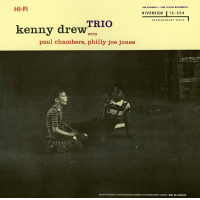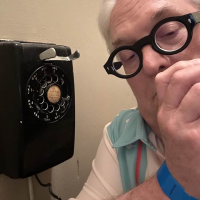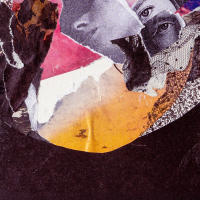Home » Jazz Musicians » Kenny Drew
Kenny Drew
Kenny Drew was born in New York City in August of 1928. At the age of 5, he began studying classical piano with a private teacher and at 8, gave a recital. This early background is similar to that of Bud Powell, the man who later became his main inspiration as a jazz pianist. After digging Fats Waller, at 12, and then Art Tatum and Teddy Wilson, Drew attended the High School of Music and Art. He was known as a hot boogie woogie player but passed through this phase before graduation.
Kenny's first professional job was as accompanist at Pearl Primus' dance school. At the same time, he was alternating with Walter Bishop Jr. in a neighborhood band that included Sonny Rollins, Jackie McLean and Art Taylor. In this period, he used to hang-out on 52nd Street to listen to Charlie Parker and Powell and began sitting in at various jam sessions around town.
In January of 1950, Drew made his first appearance on record, with Blue Note. Howard McGhee was the leader and the other featured soloists were Brew Moore and J.J. Johnson. One of the six sides released was "I'll Remember April." The label, in addition to stating "Howard McGhee's All Stars", further read, "Introducing Kenny Drew."
Later, in 1953, Kenny made his first album as a leader. Again it was Blue Note who recorded him, this time in a trio with Curly Russell and Art Blakey. But Kenny opted to settle in Los Angeles for the next few years. There in 1955, he formed a quartet with the late Joe Maini, Leroy Vinnegar and Lawrence Marable. The quartet first recorded together in 1955 for Pacific Jazz. In December, Jazz West, a subsidiary of Aladdin Records, brought the quartet as is into Capitol's recording studios for “Talkin' & Walkin'.”
In February of '56, Kenny's band and arrangements were used for another Jazz West release, this one by vocalist Jane Fielding. A month later, Drew, Paul Chambers, John Coltrane and Philly Joe Jones made the great “Chambers' Music” for the same label, which is now reissued on Blue Note.
In early 1957 Kenny made his way back to New York as accompanist for Dinah Washington. That September, he participated in John Coltrane's monumental masterpiece “Blue Train,” but his association with Blue Note did not heat up again until 1960 when he made his own “Undercurrent” as well as Jackie McLean's “Bluesnik,” and “Jackie's Bag,” Kenny Dorham's “Whistle Stop,” Dexter Godon's “Dexter Calling,” Grant Green's “Sunday Mornin'” and a couple of Tina Brooks dates all within the space of a year.
Read moreTags
Kenny Drew: Kenny Drew Trio

by C. Andrew Hovan
One of many American jazz musicians who made Europe home beginning in the early 1960s, pianist Kenny Drew is best remembered as the pianist on John Coltrane's seminal Blue Train--when he is remembered at all. Over the course of his career, Drew forged notable associations with Dexter Gordon and Jackie McLean, and recorded nearly 50 albums as a leader, most prominently Undercurrent (Blue Note, 1961) and Dark Beauty (SteepleChase, 1974). Passing away at the relatively young age of sixty-four, one ...
Continue ReadingJames Brandon Lewis, Kenny Drew, Satoko Fujii, Julian Lage

by David Brown
We kick off the show with some works that blur the lines of genre from James Brandon Lewis, Mary Halvorson and the Chicago Underground Duo; move into a set of late '50s recordings by pianist Kenny Drew, and then take off in all directions from there: piano trios from Satoko Fujii, Marc Copland and Matthew Shipp; birthday tributes to Sarah Vaughn (100!), Ben Webster, Pee Wee Russell and Orrin Evans; and wrap up with a set of works featuring guitarist ...
Continue ReadingKenny Drew and His Progressive Piano

by C. Michael Bailey
As a commercial release, the 12-inch LP Kenny Drew and His Progressive Piano has a curious history. It was also released under the title The Modernity of Kenny Drew and contained music from two recording sessions, one held in New York City In 1953 and the second in Los Angeles in 1954. Some of the sides released here were originally released as a 10-inch LP entitled The Ideation of Kenny Drew. Got that straight? This was the release paradigm back ...
Continue ReadingNew Faces - New Sounds

by C. Michael Bailey
In the early 1950s, Blue Note Records introduced new artists in the label's series New Faces -New Sounds. It highlighted such young artists as Horace Silver (1952); Lou Donaldson (1952); Elmo Hope (1953); and Frank Foster (1954). All of these recordings were released as part of Blue Note Record's 5000 Modern Jazz Series, all on 10-inch vinyl 33&1/3 LPs. This electronic space considered earlier Wynton Kelly's debut recording New Faces -New Sounds (1951) and now turns to another pianist with ...
Continue ReadingTina Brooks Quintet: The Complete Recordings

by Chris May
Mosaic Records' spring 2020 release The Complete Hank Mobley Blue Note Sessions 1963-70, the second of the label's box sets devoted to the copiously recorded (and rightly so) Hank Mobley, prompts thoughts of another of Blue Note's singular hard-bop tenor saxophone stylists. Unlike Mobley, Tina Brooks was woefully under-recorded, making just four albums under his own name. But like Mobley, Brooks had an instantly recognisable sound, was a spellbinding soloist and was also a gifted composer. In addition to his ...
Continue ReadingDexter Gordon: Tokyo 1975

by Mike Jurkovic
Though in many regards a standard, none-too-frenetic quartet setting, Dexter Gordon Quartet Tokyo 1975 is still as grand a starting point for Elemental Music's inaugural launch of previously unreleased jazz performances as can be. Gordon found himself exuberantly liberated from the antiquated (and sadly all too present) prejudices of America during his fourteen-year expatriation to Europe from 1962 to '76. Working and living primarily in Paris and Copenhagen, Gordon gigged and recorded with visiting friends and fellow expats ...
Continue ReadingDexter Gordon Quartet: Tokyo 1975

by C. Michael Bailey
Elemental Music is a record label that can be uttered in the same breath with Omnivore Records and Resonance Records. These labels can be credited with significant additions to the universal jazz catalog. Near recent examples of unreleased performances put out by Elemental Music include: Art Pepper Live At Fat Tuesday's (2015) and Red Garland's Swingin' On The Korner: Live At Keystone Korner (2015), as well as Jimmy Giuffre: New York Concerts (2014). Elemental Music has since found ...
Continue ReadingKenny Drew Jr. v. Dad

Source:
JazzWax by Marc Myers
Little is known about Kenny Drew Jr., one of jazz's finest pianists in the post-1960s era. Drew Jr. was the son of Kenny Drew, a superb bebop pianist who recorded with Charlie Parker, Lester Young, Coleman Hawkins and Miles Davis, among others. He also was on John Coltrane's Blue Trane, Sonny Rollins's Tour de Force and Jackie McLean's Jackie's Bag, to name just a few great albums. He moved to Paris in 1961 and then to Copenhagen in 1964, dying ...
read more
Remembering Kenny Drew

Source:
Rifftides by Doug Ramsey
Had he lived, pianist Kenny Drew would have celebrated his 87th birthday today. Drew first recorded with trumpeter Howard McGhee in 1950, when he was 22. He went on to play and record with many of the leading artists in jazz, including Coleman Hawkins, Lester Young, Charlie Parker, Buddy DeFranco, Dinah Washington, Art Blakey, John Coltrane, Zoot Sims, Johnny Griffin and Buddy Rich. Drew settled in Paris in 1961 and moved to Copenhagen three years later, where he became a ...
read more
Buddy Defranco and Kenny Drew

Source:
JazzWax by Marc Myers
Clarinetist Buddy DeFranco and pianist George Shearing toyed with a quintet format in the late 1940s. But before they could record together, the two went their separate ways in 1949. Buddy signed with Capitol and Shearing with MGM, bringing in vibraphonist Margie Hyams to assume Buddy's sound. But by 1951, Buddy decided to join MGM as well, recording first with his big band and then a series of bebop quartets. The group's first pianist was Kenny Drew. Buddy and Drew ...
read more
Kenny Drew Jr. (1958-2014)

Source:
JazzWax by Marc Myers
Kenny Drew Jr., son of hard bop pianist Kenny Drew and an impeccable jazz pianist in his own right who could play with dashing swing, breathtaking control and lush romanticism, died on August 3. He was 56. Drew, whose very name placed him in the shadow of his father and who died one day before his father passed away in August 1993, focused initially on classical and then pop before he began recording jazz in the late 1980s. Sitting at ...
read more
Kenny Drew Jr. At Venice Fl Art Center October 19

Source:
Don Mopsick
Internationally-known jazz pianist Kenny Drew Jr. will appear with Bruce Wallace and Tom Carabasi at the Venice Art Center Friday, October 19th from 2 to 4 PM in a concert presented by the South County Jazz Club. Drew, who is equally at home in the jazz and classical realms, is known for his hard-swinging bluesy sound and larger, two-handed rooty chords contrasting with fast runs. After winning the Great American Jazz Competition in Jacksonville, Florida in 1990, he played and ...
read more
Chamber Music Society of New York Presents Chopin, Schumann, and Beyond by Kenny Drew, Jr. on March 24th

Source:
Michael Ricci
Ever thought you would hear Chopin, Schumann, and Jazz all in the same sentence? Come celebrate Chopin and Schumann's 200th anniversaries with jazz pianist Kenny Drew, Jr. in a rare New York City appearance at the Lyric Chamber Music Society of New York. Drew Jr. will perform pieces by Chopin, Schumann, as well as his own Variations on a Theme of Schumann. Playing a mix of jazz and classical styles, Drew is sure to impress all who attend. Meet the ...
read more






































